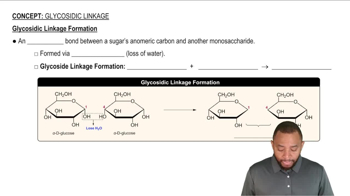Textbook Question
ALLIED Health The sugar alcohol erythritol is often included in low-calorie sweeteners. It is 70% as sweet as table sugar. Erythritol is the reduced form of the aldotetrose erythrose. Draw erythritol.
<IMAGE>
d-Erythrose
25
views
 Verified step by step guidance
Verified step by step guidance



ALLIED Health The sugar alcohol erythritol is often included in low-calorie sweeteners. It is 70% as sweet as table sugar. Erythritol is the reduced form of the aldotetrose erythrose. Draw erythritol.
<IMAGE>
d-Erythrose
Identify the following reactions as condensation or hydrolysis:
(a) two monosaccharides reacting to form a disaccharide
Name the glycosidic bond present in mannobiose, shown in the following figure:
<IMAGE>
Mannobiose
Explain the difference between an aldose and a ketose.
Describe the properties of soluble fiber.
Name the functional groups present in aldoses.